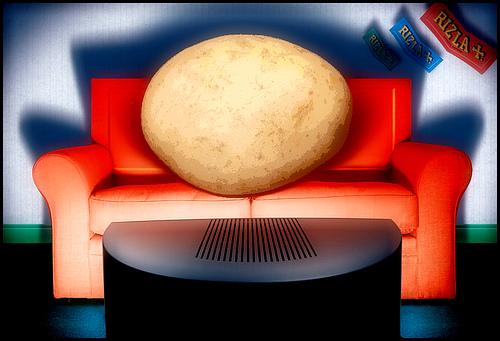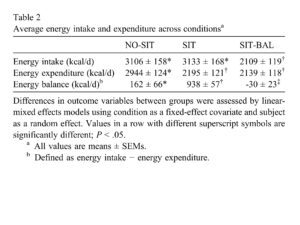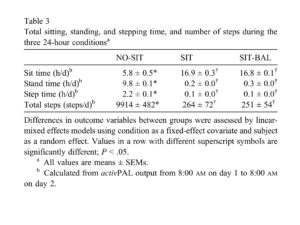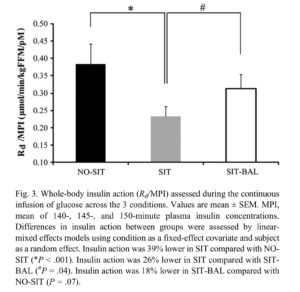In summary, the following conclusions can be made:
- Just one day of prolonged sitting had a profound effect on insulin action.
- Sitting therefore has a direct effect on metabolic health by substantially reducing the body’s ability to dispose of, or “metabolise” the foods we consume.
- These negative effects occurred in young, healthy and non-obese individuals.
- Future research is required to determine if factors such as aging, obesity, health comorbidities and inactivity interact independently or synergistically to cause further metabolic dysfunction.
- Decreasing energy or caloric intake to more closely match the energy requirements of prolonged sitting only reduced – by approximately half – the harmful effects of sitting on insulin action.
- Inactivity and sedentariness causes substantial metabolic dysfunction with sitting a primary driver of poor insulin action and pivotal contributor to increased risk for more serious health complications.
- Now for those that want the in-depth analysis, please read on………………………………..
Whilst this seems to pass the common sense test, this is quite significant because many of the themes on the net and in the mass media that discuss ways of improving metabolic health focus heavily on diet, but relatively less time and energy seems to be dedicated to exploring the detrimental effects of inactivity largely accumulated by spending long periods of time sitting. I call this the
diet fixation syndrome
and it manifests in a utopian idea that diet and nutrition can fix almost anything. Enhancing health and wellbeing via diet is certainly a worthwhile cause but many pontificate their beliefs in such a manner whereby they assume some moral high ground lost in an idea that the consumption of “their” diet is as nature intended and then maintain with religious fervidness that any deviation from this ‘correct’ dietary approach will be somehow toxic, dangerous and unhealthy. “They” can’t all be right, can they? By “They” I mean the paleos, the vegans, the High-Fat Low-Carbers, the High-Carb Low Fat crowd, etc etc. I am not saying that the food we feed our body is unimportant but I do think that there needs to be more acknowledgment and discussion of the diabolical impact inactivity has as demonstrated by a significant body of scientific evidence. Otherwise, we will continue to see the oxygen sucked from, and being straggled and muffled by, the nutrition “hype”.

OK, well that’s enough with the popular culture critique; now let’s look at some of the science behind what happens to metabolic health when we are sedentary and I’m afraid to say the picture is pretty ugly. In this study Stephens and co. recruited fourteen recreationally active men (n=7) and women (n=7) between the age of 19 and 32 participated, of whom none were obese, all were in good health, non-smoking, free of known disease, not following a very low or very high carbohydrate diet (<30% or >70%), and none were taking any medications or supplements known to alter carb or fat metabolism. The intention of the study was to compare all participants for each test condition.
The 3 test conditions were: (1) an active condition with minimal sitting (energy expenditure and intake were both high) referred to as NO-SIT; (2) Prolonged sitting with no change in energy intake meaning that there was low activity but high energy intake i.e energy surplus referred to as SIT; (3) Prolonged sitting but energy intake was adjusted downward and accordingly to body weight (approximately 1000 kcal reduction) and this was referred to as SIT-BAL. Insulin action was defined as whole-body rate of glucose disappearance normalised to mean plasma insulin and this was determined following a continuous infusion of glucose after an overnight fast (13-14 hours) after each of the test conditions outlined above.
Insulin action was used as a proxy measure of metabolic health with better metabolic function reflected by lower insulin production, higher glucose metabolism and storage. Subjects completed each 24-hour laboratory condition with at least a week between visits. For the 2 days before each 24-hour test condition, attempts were made to ensure that eating and activity behaviour were standardised. Once in the laboratory room each subject was provided access to a computer, internet, books, magazines, or movies throughout the day and evening. Lunch and dinner during the test was standardised. Average energy intake and expenditure across each condition was approximately as follows (please click image for larger and clearer view):
Activity or inactivity was quantified using an activPAL professional physical activity monitor and this has been shown to be an accurate and reliable measurement tool to determining motion. Standardised meals based on body weight were provided. Total sitting, standing, and stepping time, and number of steps during the three 24-hour conditions was as follows:
So basically picture this. When subjects did the SIT and SIT-BAL experiment they sat and lounged around all day in a lab room, watching video’s, surfing the net and reading mags and doing as little as possible, with SIT able to indulge and eat well over what they needed whilst SIT-BAL had their food intake dramatically reduced so it matched the low energy they had burnt. Interestingly, it is the SIT condition which probably represents a significant portion of how many people spend their day so the results would provide some insight to what is really going on in those who are grossly sedentary and in energy surplus on a day-to-day basis.
In comparison, the NO-SIT ensured that subjects were on the go: stood while reading, talking on the phone, whilst on the computer; made subjects walk and accumulate at least 10,000 steps/day, perform tasks such as dish washing, sweeping, dusting etc. After spending 24 hours in the lab after each test condition, they were then injected and hooked up to a machine that pumped in different amounts of glucose (sugar) and blood samples were taken to measure insulin and glucose concentrations. These parameters were then assessed to work out how much insulin was produced in response to the glucose infusion and how well the body was then able to dispose of the glucose that was given. Generally higher insulin concentrations and reduced glucose disposal was indicative of impaired metabolic health and function.
What were the results?
The following parameters were significantly different between each test condition:
1. Mean plasma insulin (during glucose infusion)
Compared with NO-SIT, mean plasma insulin was 41% higher in SIT, whilst 18% greater levels were seen for SIT compared to SIT-BAL.
2. Total glucose disposal
During the glucose load, total disposal was lower in SIT compared with both NO-SIT and SIT-BAL.
3. Whole-body insulin action (glucose disposal normalised to mean plasma insulin)
SIT was 39% lower relative to NO-SIT and SIT was 17.7% lower compared to SIT-BAL.
4. Carbohydrate oxidation rate
SIT-BAL was 22% lower compared to NO-SIT and 19% lower compared to SIT.
5. Average energy intake and expenditure
a) Energy intake for SIT-BAL was approximately 32% lower than NO-SIT and SIT.
b) Energy expenditure for SIT and SIT-BAL was approximately 26% lower compared to NO-SIT.
c) Energy balance was different for all conditions. NO-SIT was in energy surplus by +162 kcal/day vs. SIT which was in surplus by +938 kcal/day vs. SIT-BAL which was in energy deficit by approximately -30 kcal/day.
6. Total sitting, standing and stepping time and number of steps
NO-SIT was significantly different to SIT and SIT-BAL but there was no difference between SIT and SIT-BAL.
Please refer to tables 2, 3 and 4 for a full report of the results of this study.
So what is the take-home message?
Prolonged sitting is very, very bad for us. This study showed that just one day of prolonged sitting had a massive impact on insulin action and therefore compromises metabolic function and health quite dramatically. Even if you reduce the food you eat – to lower your energy intake to more closely match your low energy expenditure when sitting for prolonged periods – insulin action is not fully restored to that seen when activity levels are high. The logical inference to make from this is that sitting for prolonged periods of time is not natural for our species. One of the obvious features of what makes ‘us’ who and what ‘we’ are, is the fact that we have a musculoskeletal system that is designed for physical movement and it is the lack of stimulation of this during waking hours that has very dire consequences.
The results also suggest that energy surplus (i.e. consuming food/beverages beyond energy requirements) plays a key role in the harmful effects of sitting on insulin action. As shown in previous studies energy surplus or an overabundance of fatty acids, glucose and/or amino acids inhibits key components of the insulin signalling pathway. Therefore, it is important that we look beyond just excessive carbohydrates or sugar – notwithstanding that reducing sugar intake remains an important dietary change to make – and acknowledge that a chronic state of energy surplus will reek havoc on our metabolic health irrespective of the macronutrient basis of any excess consumed. Currently, there is no scientific consensus for the notion that one macronutrient poses more risk to metabolic health when in energy surplus if you are healthy and insulin-sensitive. Until such time that evidence proves otherwise, it is the state of being in energy surplus that causes insulin action and metabolic health to be compromised not the source of the excess.
There are 2 more very important things to take note of to put this study into perspective. Firstly, if you refer to the results above and table 2 specifically, you will notice that NO-SIT was in energy surplus by approximately +162 kcal/day versus SIT-BAL which was in energy deficit by approximately -30 kcal/day. You may be wondering why this is important and worthy of comment. Basically due to this difference, the true impact of sitting on insulin action could have actually been underestimated with the real difference between these 2 condition possibly even larger than what was found. Had NO-SIT been in energy balance and not energy surplus, insulin action could have been better than that measured and hence when compared to SIT-BAL a greater difference would have been observed. Secondly, the study subjects were young, healthy and non-obese so it is difficult to extrapolate the findings to other less healthy, older and/or obese populations. What can be said is that prolonged sitting or inactivity would certainly not enhance insulin action and metabolic health in those that that are older and/or suffer from chronic health conditions. So pretty much the advice would be the same.
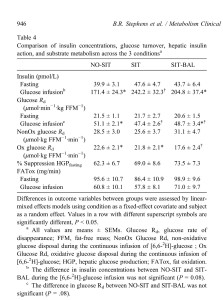
Finally, I would like to make some big picture comments that can possibly be deduced from this study. It is pretty obvious, I think, why health conditions such as obesity and insulin resistance have become endemic. To make clear:
this study showed that nutritional manipulation by reducing energy intake to match low energy expenditure of inactivity (SIT-BAL) only reduced approximately one half of the harmful effects of sitting on insulin action.
It is therefore feasible that impaired glucose metabolism and insulin resistance could be developed in the non-obese who are normal weight or Body Mass Index (BMI) if there is gross long-term inactivity. Consequently, we should be cognisant of the dangers of inactivity and refocus some of our energy and attention away from diet and nutrition as being the only answer to these problems. The solution seems very simple indeed but that would mean that people would have to move a whole lot more as well as modify and show greater restraint in their eating habits but that unfortunately seems very unlikely to occur anytime soon.
For local Townsville residents interested in FitGreyStrong’s Exercise Physiology services or exercise programs designed to achieve the above-mentioned benefits or to enhance athletic performance, contact FitGreyStrong@outlook.com or phone 0499 846 955 for a confidential discussion.
For other Australian residents or oversees readers interested in our services, please see here.
Disclaimer: All contents of the FitGreyStrong website/blog are provided for information and education purposes only. Those interested in making changes to their exercise, lifestyle, dietary, supplement or medication regimens should consult a relevantly qualified and competent health care professional. Those who decide to apply or implement any of the information, advice, and/or recommendations on this website do so knowingly and at their own risk. The owner and any contributors to this site accept no responsibility or liability whatsoever for any harm caused, real or imagined, from the use or distribution of information found at FitGreyStrong. Please leave this site immediately if you, the reader, find any of these conditions not acceptable.
